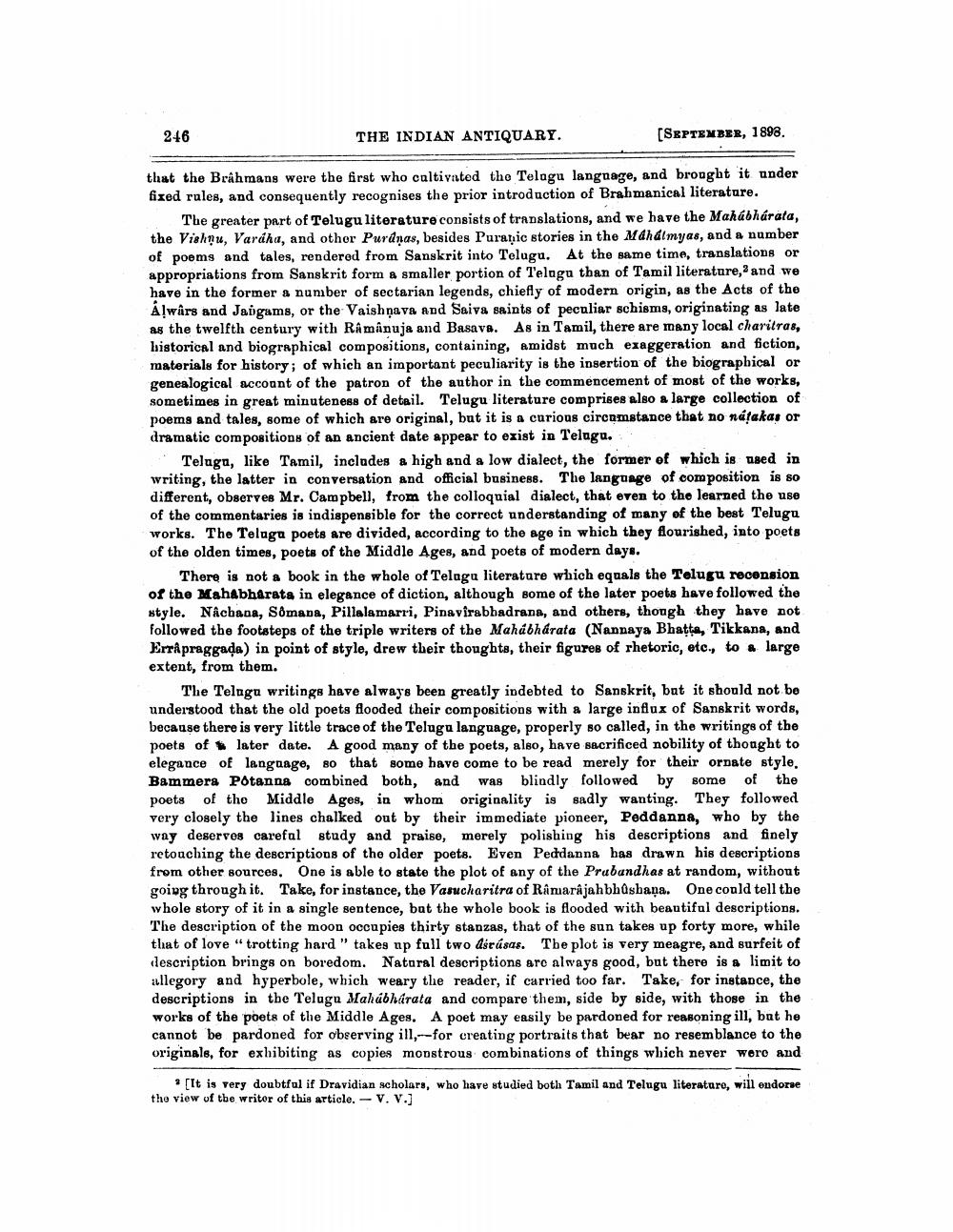________________
246
THE INDIAN ANTIQUARY.
[SEPTEMBER, 1898.
that the Brahmans were the first who caltivated tho Telugu language, and brought it under fixed rules, and consequently recognises the prior introduction of Brahmanical literature.
The greater part of Telugu literature consists of translations, and we have the Mahabharata, the Vishnu, Vardha, and other Puranas, besides Puranic stories in the Mahatmyas, and a number of poems and tales, rendered from Sanskrit into Telugu. At the same time, translations or appropriations from Sanskrit form a smaller portion of Telugu than of Tamil literature, and we have in the former a number of sectarian legends, chiefly of modern origin, as the Acts of the A!wêrs and Jaigams, or the Vaishnava and Saiva saints of peculiar schisms, originating as late as the twelfth century with Ramanuja and Basave. As in Tamil, there are many local charitras, historical and biographical compositions, containing, amidst much exaggeration and fiction, materials for history; of which an important peculiarity is the insertion of the biographical or genealogical account of the patron of the author in the commencement of most of the works, sometimes in great minuteness of detail. Telugu literature comprises also a large collection of poems and tales, some of which are original, but it is a curious circnmstance that no náțakas or dramatic compositions of an ancient date appear to exist in Telugu.
Teluga, like Tamil, includes a high and a low dialect, the former of which is used in writing, the latter in conversation and official business. The language of composition is so different, observes Mr. Campbell, from the colloquial dialect, that even to the learned the use of the commentaries is indispensible for the correct understanding of many of the best Telugu works. The Telugu poets are divided, according to the age in which they flourished, into poets of the olden times, poets of the Middle Ages, and poets of modern days.
There is not a book in the whole of Telaga literature which equals the Telugu recension of the Mahabharata in elegance of diction, although some of the later poets have followed the style. Nácbana, Somana, Pillalamarri, Pinavirabhadrana, and others, though they have not followed the footsteps of the triple writers of the Mahabharata (Nannaya Bhatta, Tikkana, and Errâpraggada) in point of style, drew their thoughts, their figures of rhetoric, etc., to a large extent, from them.
The Telaga writings have always been greatly indebted to Sanskrit, bat it should not be understood that the old poets flooded their compositions with a large influx of Sanskrit words, because there is very little trace of the Telugu language, properly so called, in the writings of the poets of later date. A good many of the poets, also, have sacrificed nobility of thought to elegance of language, 80 that some have come to be read merely for their ordate style. Bammera Potanna combined both, and was blindly followed by some of the poets of the Middle Ages, in whom originality is sadly wanting. They followed very closely the lines chalked out by their immediate pioneer, Peddanna, who by the way deserves careful study and praise, merely polishing his descriptions and finely retouching the descriptions of the older poets. Even Peddanna has drawn his descriptions from other sources. One is able to state the plot of any of the Prabandhas at random, without going through it. Take, for instance, the Vasucharitra of Ranarajahbhashana. One could tell the whole story of it in a single sentence, but the whole book is flooded with beautiful descriptions. The description of the moon occupies thirty stanzas, that of the sun takes up forty more, while that of love "trotting hard " takes up full two dírásas. The plot is very meagre, and surfeit of description brings on boredom. Natural descriptions are always good, but there is a limit to allegory and hyperbole, which weary the reader, if carried too far. Take, for instance, the descriptions in the Telugu Mahabharata and compare them, side by side, with those in the works of the poets of the Middle Ages. A poet may easily be pardoned for reasoning ill, but he cannot be pardoned for observing ill. --for creating portraits that bear no resemblance to the originals, for exhibiting as copies monstrous combinations of things which never were and
[It is very doubtful if Dravidian scholars, who have studied both Tamil and Telugu literature, will endorse the view of the writer of this article. - V. V.]




